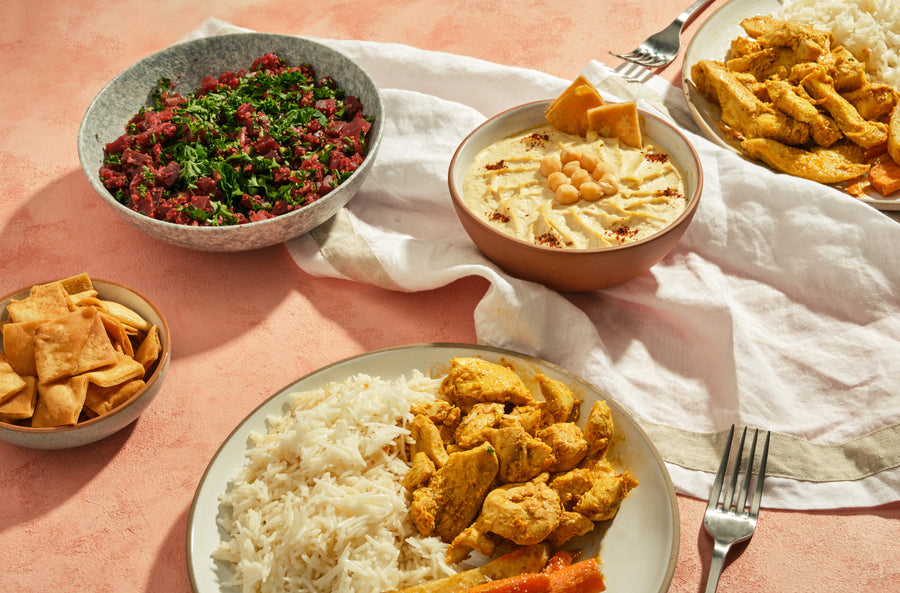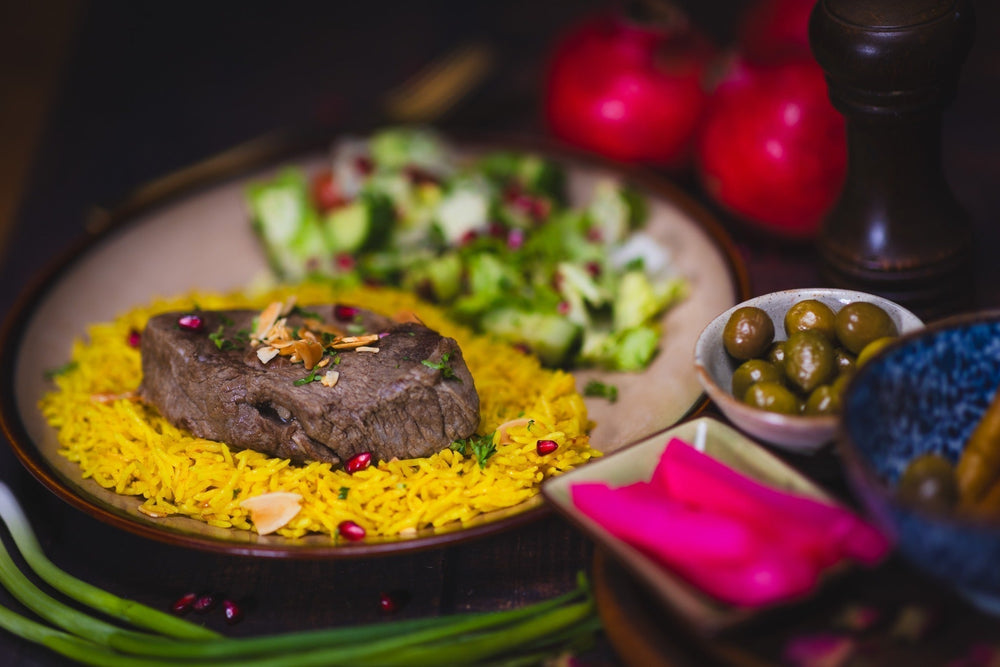All Concerning the Rich Flavors and Traditions of Syrian Food: A Culinary Trip
Syrian food uses a special mix of flavors and practices that mirror its rich social background. With staple active ingredients like olive oil and garlic, alongside a range of flavors, the meals are both varied and welcoming. From the intricate preparation of kibbeh to the wonderful allure of baklava, each aspect of this cooking landscape exposes deeper tales. As one checks out the essence of these tastes, a higher understanding of common dining and party emerges.
The Essence of Syrian Ingredients
The significance of Syrian components lies in their rich diversity and ingrained cultural value. Influenced by the country's varied location and history, Syrian food integrates a broad range of seasonings, natural herbs, and fresh produce. Staples such as olive oil, garlic, and lemon supply a foundation, while spices like coriander, cumin, and sumac include depth and complexity to dishes.The use fresh natural herbs, including parsley and mint, highlights the relevance of seasonal components. Additionally, the region's productive dirt yields a wealth of veggies and fruits, such as tomatoes, eggplants, and pomegranates, which are important to many dishes. Grains like bulgur and rice create the base of numerous meals, highlighting the value of these ingredients in Syrian culture. This mix of flavors shows not just a culinary tradition however also a tapestry of historic influences, making Syrian active ingredients crucial to comprehending its food's vibrant personality.

Iconic Dishes of Syrian Cuisine
Syrian cuisine is renowned for its legendary recipes that display a rich tapestry of structures and flavors. Standard meze plates offer a selection of tiny meals that tantalize the taste buds, while hearty main training courses supply gratifying focal points for dishes (Afternoon Tea Vancouver). To finish the experience, a selection of delightful treats adds a pleasant note to the cooking journey
Typical Meze Plates

Hearty Main Courses
Passionate main dishes serve as the focal point of Syrian dining, showcasing a blend of tastes that show the country's rich cooking traditions. Dishes such as kebab hindi, featuring seasoned lamb skewers, and the renowned mujaddara, a calming mix of lentils and rice, highlight the use of fresh ingredients and aromatic spices. Another staple is the legendary kibbeh, made from bulgur wheat and minced meat, commonly offered in various kinds, including baked, fried, or raw. Furthermore, the tastes of the land come alive in dishes like stuffed vegetables, referred to as mahshi, which are full of rice, meat, and herbs. These primary programs not just please hunger however also inform tales of family members events and social heritage.
Scrumptious Treats Option
A wonderful variety of treats defines the sweet side of Syrian cuisine, supplying a tantalizing end to any type of dish. Amongst one of the most popular confections are baklava, fragile layers of phyllo pastry full of nuts and soaked in syrup, and maamoul, shortbread-like cookies commonly stuffed with dates or nuts. Knafeh, a rich dessert made from thin noodle-like pastry soaked in syrup and layered with cheese, is a prominent option, particularly during festive events. Furthermore, the wonderful and fragrant rice dessert, known as roz bil laban, provides a comforting coating. These delightful desserts not just display the area's cooking know-how however likewise mirror the social heritage of Syria, making them cherished deals with in both homes and restaurants alike.
Typical Food Preparation Methods
Contemporary conveniences have actually affected several culinary practices, typical food preparation techniques remain crucial to Syrian food. These methods usually stress making use of fresh, seasonal active ingredients and concentrate on slow-moving cooking to establish abundant flavors. Methods such as grilling, braising, and cooking are common, enabling the natural preferences of the components to beam through.One significant technique is the preparation of kibbeh, a dish made from carefully ground meat and bulgur. It calls for proficient hand-rolling into different forms and can be baked, deep-fried, or served raw. In addition, the art of making bread, particularly pita, is main to numerous dishes, frequently cooked in a conventional stone oven.Preservation techniques like pickling and fermenting also play an important function, enhancing the variety of flavors located in Syrian dishes. These methods not just mirror the region's farming heritage however additionally promote a strong sense of community with shared cooking techniques.

The Duty of Spices in Flavoring
Seasonings function as the heartbeat of Syrian food, infusing meals with complex flavors and fragrant depth. Each flavor plays a crucial function, adding not just to taste but also to the social heritage of the region. Generally utilized seasonings include sumac, cumin, and coriander, each providing a special profile that raises traditional dishes. Cumin provides heat and earthiness, while sumac includes a zesty brightness, boosting the overall dish.Syrian chefs often blend spices to develop harmonious accounts, reflecting the complex equilibrium of tastes that define the cuisine. The usage of seasonings is not merely for seasoning; it also offers to maintain food and boost its nutritional value. This thoughtful consolidation highlights a deep understanding of the cookeries, where seasonings end up being necessary authors, communicating the abundant background and varied impacts that identify Syrian gastronomy. Inevitably, seasonings are essential in crafting genuine and memorable Syrian dishes.
Commemorative Meals and Joyful Custom-mades
Celebratory meals in Syrian food are noted by traditional feast meals that reflect the nation's rich cooking heritage. Unique events frequently include distinct routines that enhance the communal experience of dining. These custom-mades not only recognize the value of the events yet also enhance familial and social bonds.
Conventional Feast Cuisines
When families collect to commemorate substantial events in Syria, standard feast dishes take spotlight, showcasing the abundant culinary heritage of the area. These gatherings commonly include vivid platters of mezze, consisting of hummus, baba ghanoush, and tabbouleh, which function as delightful starters. The main dish normally highlights lamb or chicken, seasoned and prepared to perfection, often gone along with by aromatic rice pilaf or bulgur. Among the most cherished recipes is maqlooba, a layered rice recipe with vegetables and meat, turned upside down prior to offering. Sweets likewise play an essential function, with baklava and knafeh browse this site using a sweet coating to the meal. Each dish not only delights the palate yet likewise reflects the ingrained traditions and communal spirit of Syrian culture.
Unique Event Routines
Unique events in Syria are noted by rich rituals that intertwine food and celebration, mirroring the social value of common gatherings. Celebratory dishes typically consist of standard meals such as kibbeh, tabbouleh, and various barbequed meats, prepared with care and shared among family and friends. Throughout religious holidays like Eid al-Fitr and Eid al-Adha, households integrated to prepare unique sugary foods like maamoul, signifying unity and pleasure. Wedding events are specifically fancy, including several courses and dynamic displays of friendliness. These occasions are not simply about food; they incorporate narration, dance, and songs, enhancing social bonds and cultural heritage. Through these rituals, Syrians commemorate life's turning points, making sure practices are given with generations, improving their cooking landscape.
The Relevance of Sharing and Community
Sharing meals is a basic facet of Syrian culture, mirroring the deep-rooted values of neighborhood and connection. In Syria, food is not simply food however a means of bringing individuals together. Friends and families gather around the table to enjoy standard meals, promoting bonds and producing enduring memories. This common dining experience emphasizes friendliness, where hosts go to excellent sizes to assure every guest really feels invited and nourished.The act of sharing food also symbolizes kindness and uniformity, enhancing social ties within communities and larger neighborhoods. Throughout gatherings, it is common for individuals to offer each other, showcasing a spirit of togetherness that goes beyond individuality. Parties, whether big or tiny, are frequently noted by the sharing of dishes, where varied tastes and recipes integrated, mirroring the rich tapestry of Syrian culture. Appropriately, the importance of sharing and neighborhood in Syrian cuisine is not just a cooking practice yet a vital social method.
A Culinary Exploration of Syrian Desserts
Typically outweighed by full-flavored recipes, Syrian desserts hold a treasured location in the nation's cooking heritage (Afternoon Tea Vancouver). These confections reflect the area's abundant history, blending tastes and methods from different cultures. Conventional treats like baklava, with its layers of phyllo bread, nuts, and honey syrup, showcase the virtuosity involved in Syrian cooking. Ma'amoul, a shortbread-like cookie full of nuts or days, is usually gotten ready for festive events, representing hospitality and celebration.Another precious sweet is Knafeh, a pastry soaked in syrup and layered with cheese or cream, offering a delightful contrast of structures. Syrians additionally enjoy a selection of fruit protects and syrups, usually offered with tea or as part of a larger spread during events. These sweets not just satisfy the taste buds however likewise act as a bridge between generations, protecting the practices and stories of Syrian society via each delectable bite
Often Asked Concerns
What Are the Wellness Advantages of Traditional Syrian Foods?
The health and wellness benefits of typical Syrian foods consist of abundant nutrients from fresh vegetables, legumes, and entire grains. These ingredients promote heart health, improve food digestion, and provide crucial vitamins, contributing to total wellness and a well balanced diet.
Just How Has Syrian Cuisine Progressed Over the Years?
Syrian food has developed substantially, influenced by historic trade courses, cultural exchanges, and regional schedule of components. Typical read here dishes have actually integrated modern-day flavors and methods while maintaining their rich heritage, mirroring a diverse cooking landscape.
Exist Vegetarian or Vegan Options in Syrian Cuisine?
Syrian cuisine uses numerous vegan and vegan alternatives, featuring dishes like falafel, tabbouleh, and stuffed grape fallen leaves. These dishes highlight the region's abundant farming heritage, showcasing fresh vegetables, grains, and fragrant seasonings in dynamic mixes.
What Beverages Set Well With Syrian Recipes?
When thinking about beverages that complement Syrian meals, one could find that mint tea, ayran, and pomegranate juice improve the dish's tastes. Furthermore, merlot frequently pairs well with the seasonings commonly discovered in these cuisines.
Exactly How Can I Recreate Syrian Meals in your home?
To recreate Syrian meals in your home, one need to discover authentic recipes, gather standard active ingredients, and utilize cooking strategies one-of-a-kind to the food. Trying out seasonings and discussion likewise improves the total eating experience. Syrian food is renowned for its iconic meals that showcase an abundant tapestry of tastes and structures. Seasonings offer as the heartbeat of Syrian cuisine, infusing recipes with intricate flavors and fragrant depth. Commemorative dishes in Syrian cuisine are marked by here are the findings standard feast meals that mirror the country's rich cooking heritage. Events, whether big or little, are typically noted by the sharing of dishes, where varied tastes and meals come together, showing the abundant tapestry of Syrian society. Syrian cuisine offers various vegan and vegan choices, featuring dishes like falafel, tabbouleh, and packed grape leaves.